When you open File Explorer on your Windows computer, you’ll likely see drives C and D. Have you ever wondered what the difference is between them? Why are almost all system files and software installed on the C drive, while the D drive is often empty?
If you have these questions, please read on to learn about the differences between drives C and D.
C Drive vs. D Drive
Computers typically have multiple disk partitions, with the C drive and D drive being the most commonly used. To help you better understand these two disks, the following comparison will cover disk definitions, main functions, and storage capacities.
#1. D Drive vs. C Drive: Definition
What’s the difference between drive C and drive D? Let’s first look at their respective definitions.
What Is C Drive?
The C drive is the primary hard drive partition on a Windows computer. The drive letter “C” is the first available drive letter after A and B.
Drives A and B were typically reserved for floppy disks. With the advent of hard drives, to maintain compatibility with software originally designed for floppy disks, the system assigned the hard drive to the next available drive letter, C.
The C drive stores the operating system, system files, and all installed programs, and is usually the default location for saving personal files and downloaded content.
The D drive is a secondary storage location on the computer, typically used for storing data. It can be a second internal hard drive, a partition of the system disk, an optical drive (such as a DVD drive), or an external hard drive.
It is a convenient location for storing personal files, large applications, or backup files.
#2. D Drive vs. C Drive: Function & Size & Importance & Speed
The table below provides a brief comparison of the C drive and the D drive in terms of functionality, size, importance, etc.
| Features | C Drive | D Drive |
| Function | 1. Used for storing device drivers and application software. 2. Default location for files required for operating system loading and startup. | Used to store personal files. |
| Importance | It is necessary for system startup and operation, affecting computer performance. | It is not dependent on system operation and is mainly used for data management. |
| Physical Drive | It is usually installed on a faster SSD. | It may be a separate physical hard drive or a different partition on the same physical hard drive as drive C. |
| Size | It may be large or small, as long as it leaves enough space for the system and software operation. | It can be large, used for storing large numbers of files and backups. |
| Speed | Faster storage devices (such as SSDs) are typically used to ensure system performance. | It can be a slower, larger drive for bulk storage, though it can also be a fast SSD. |
Bonus Tip: Why People Create So Many Partitions (E:, F:, J:, etc.)?
Many users create not just C and D drives, but also additional drives such as E, F, J, and sometimes even more.
The main reasons for this are as follows:
1. Convenient data classification and management.
People typically store system files, software, work files, and multimedia data in different partitions to facilitate easier management and retrieval.
2. Backup and security.
Having multiple partitions allows for better data backup and protection. If one partition fails (for example, due to file system corruption), the data on other partitions can still be preserved.
3. Safer system reinstallation.
If the operating system crashes or needs to be reinstalled, only the C drive needs to be formatted. Data stored on other partitions will remain intact, reducing the risk of data loss.
4. Running multiple operating systems (multi-system boot).
Each operating system (such as Windows and Linux) typically requires its own independent disk partition.
Having understood the definitions, functions, sizes, importance, and speed differences of drives C and D, the next step is to consider how to fully utilize their characteristics.
Proper use of drives C and D can not only improve system performance but also extend hard drive lifespan and prevent storage clutter.
Next, we will introduce some practical methods to help you manage and use drives C and D more efficiently.
How to Use C Drive and D Drive More Efficiently?
Many people encounter this question when using computers: How should the C and D drives be used, and how should files and applications be allocated to make the computer run faster and more stably?
The principle is actually quite simple: the C drive should be primarily used for installing the operating system and essential basic software, ensuring ample space.
Personal files, large programs, and games are best placed on the D drive. This avoids a bloated system drive affecting performance and keeps the computer running smoothly and stably.
Properly utilizing hard drive partitions can not only improve work efficiency but also extend the lifespan of your computer. Below, I will address the two common questions.
#1. What Files Should I Save on C Drive or D Drive?
The C drive is primarily used to store system-related data, such as Windows system files. Therefore, it’s best to avoid saving personal data or work files on the C drive.
Storing important data on the C drive could lead to data loss if the system encounters problems or Windows is reinstalled. Thus, the C drive is not an ideal location for storing personal files.
In contrast, the D drive is safer and more flexible. Most computers use the D drive as a data storage or recovery partition, used to store personal files, project materials, and multimedia content, making it the preferred location for file management.
#2. Which Drive Is Better for Gaming: C or D Drive?
Regarding whether the game is installed on the C drive or the D drive, here is a question from a forum user:
Local Disk (C:) = 540 GB, Data (D:) = 390 GB. I’m not sure where to put all my games, and will it slow my laptop when I put it on data (D:)? https://steamcommunity.com/discussions/forum/1/3211505894115308011/
The following are the scenarios. Please decide whether to install the game on your C drive or D drive based on your actual needs.
Case 1: If partitions C and D are on the same disk, their speeds are the same. Installing software on partition D will not affect performance.
Case 2: If partitions C and D are on two different disks, the installation location should be chosen based on the disk type.
- When both disks are SSDs, the performance difference between installing on C and D is minimal. Therefore, installing software on D keeps the system drive cleaner.
- However, if partition D is on a hard disk drive (HDD) and partition C is on an SSD, it’s best to install the necessary software on C for faster speeds.
- Conversely, programs that don’t run frequently or large files can be placed on partition D to save space on C and maintain system smoothness.
How to Extend the C Drive by Taking Free Space from the D Drive?
During daily computer use, system files, temporary files, Windows updates, system restore points, hidden folders like Windows.old, and various types of data are constantly generated.
As these files accumulate, the available space on the C drive tends to gradually decrease and eventually become full.
If your C drive is full and your D drive is empty, you can delete the D drive and extend the C drive. If your C drive is full and D drive has enough unused space, you can allocate some space from the drive D to the drive C.
The MiniTool Partition Wizard can help you easily complete this extension process.
Here are the specific steps:
MiniTool Partition Wizard DemoClick to Download100%Clean & Safe
Step 1: Any operation on the C drive may be risky. Therefore, it is advisable to first create a MiniTool bootable media. Connect a recordable USB flash drive to your computer. Then launch MiniTool Partition Wizard to its main interface, and click Bootable Media.
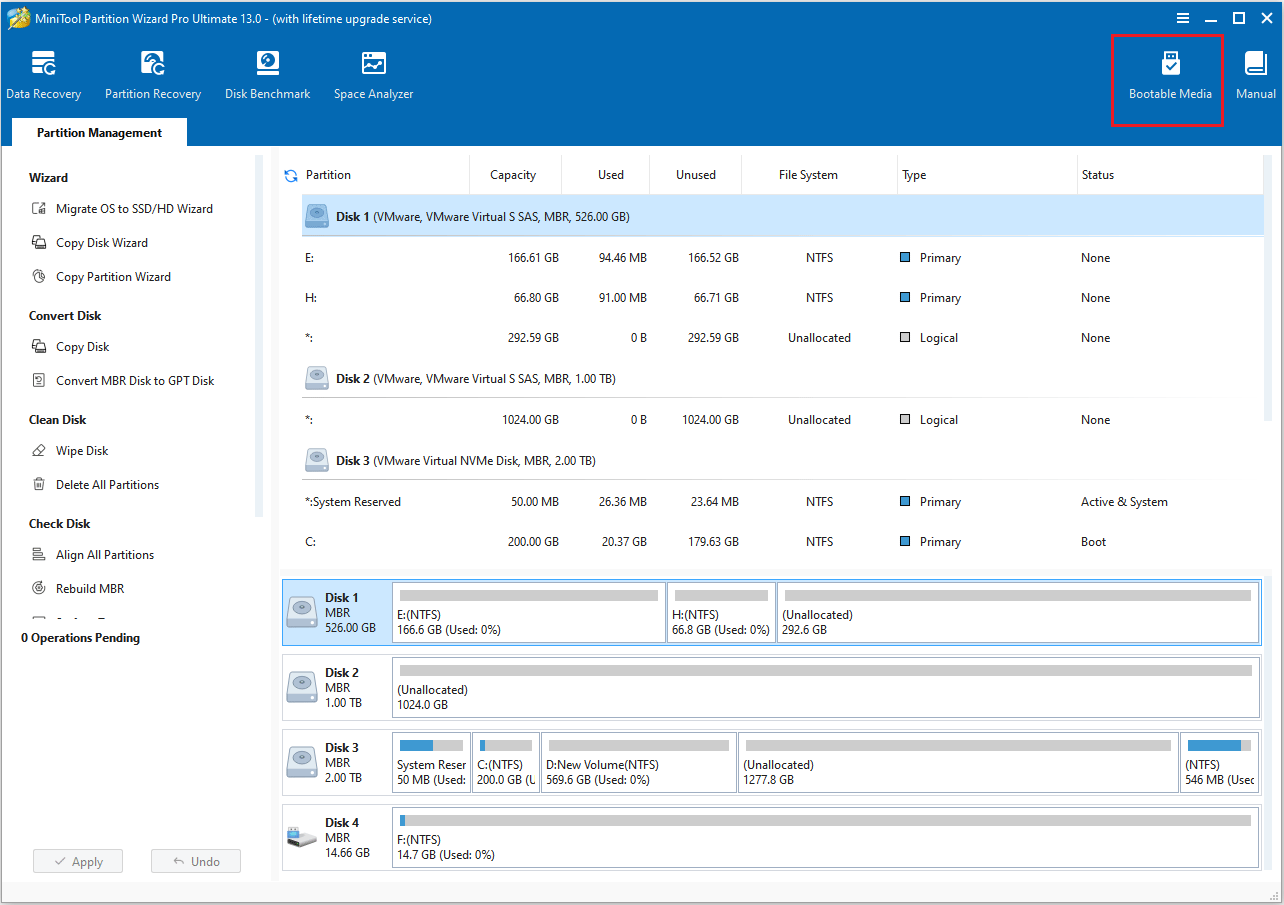
Step 2: Click WinPE-based media with MiniTool plug-in to continue.
Step 3: Select the USB Flash Drive option. A warning message will appear, and click Yes to confirm that you want to proceed with creating the bootable drive.
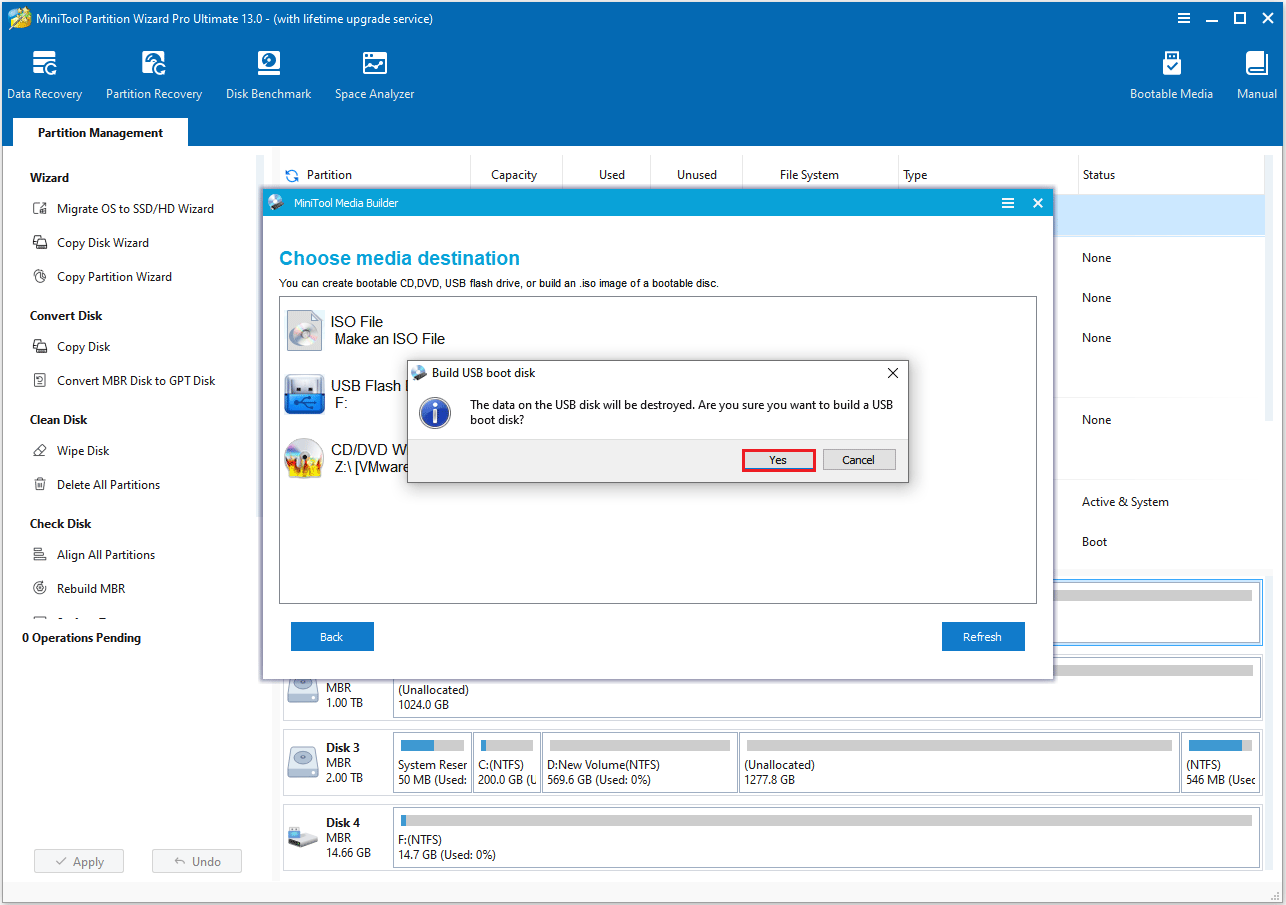
Step 4: Wait for the creation process to complete. Then, click Finish.
Step 5: Restart your computer and enter the BIOS to set it to boot from the USB drive. Then, wait until the MiniTool Partition Wizard interface opens automatically.
Step 6: In the main interface of MiniTool Partition Wizard, select the system partition and click Extend Partition from the left action pane.

Step 7: Choose the drive you want to take space from. Then, drag the sliding block to decide how much free space you want to take. Then, click the OK button.
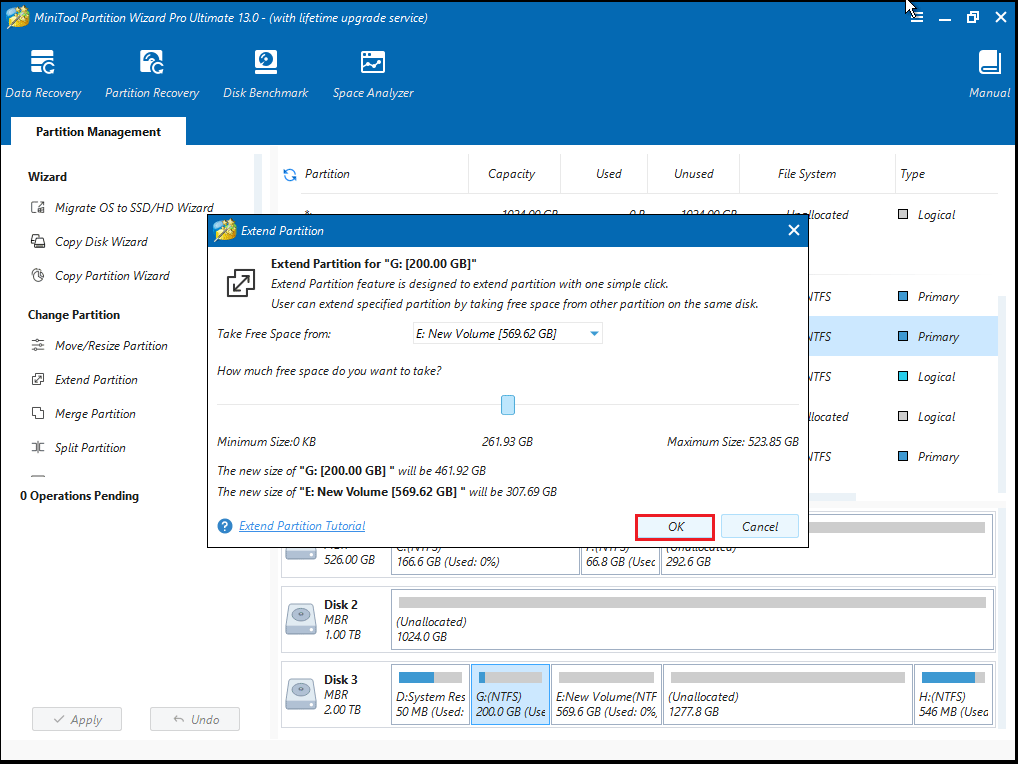
Step 8: Click the Apply button to execute pending operations.
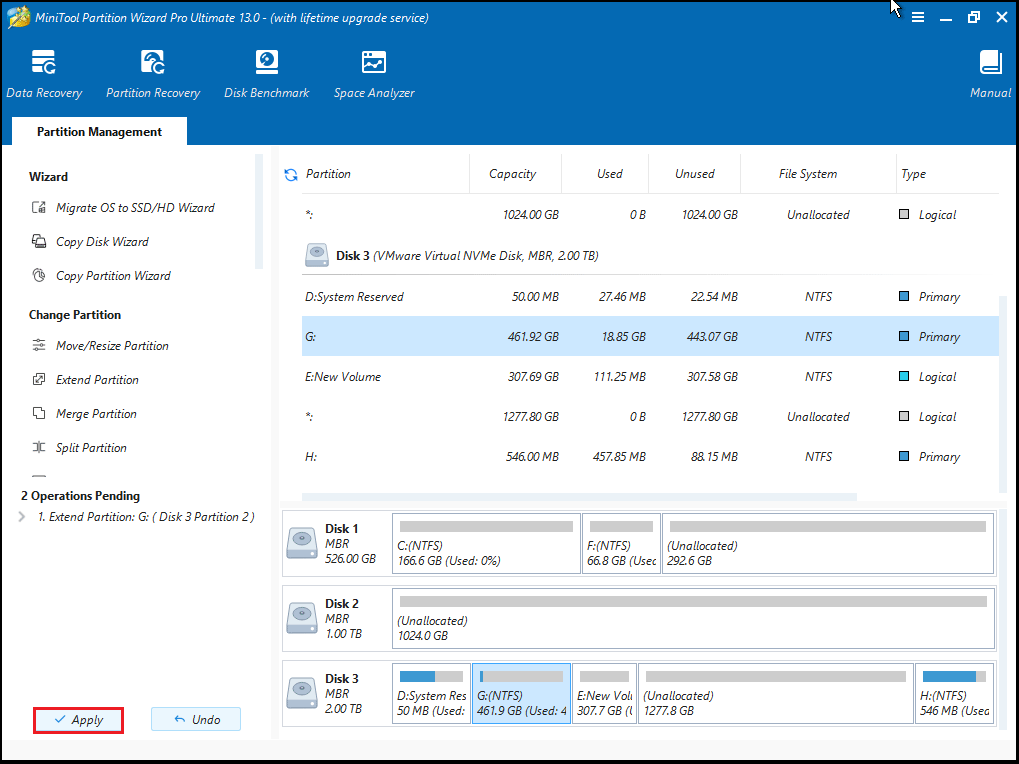
For other methods, please refer to the article “Free up disk space on PC”.
C Drive vs. D Drive FAQ
Bottom Line
Understanding the different uses of the C and D drives will allow you to manage your computer data more systematically. Store your operating system and software on the C drive, and personal files and backups on the D drive.
Also, remember to regularly clean up unnecessary files on the C drive to keep your computer running smoothly.
If you have any questions or suggestions while using MiniTool Partition Wizard, you can contact us via [email protected] for further assistance.

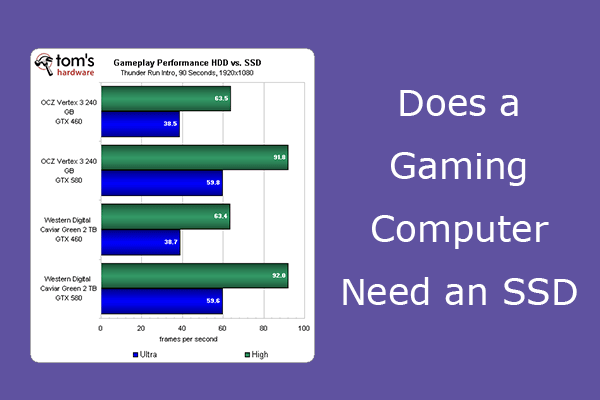
User Comments :